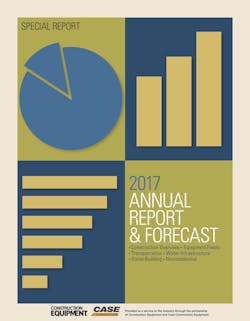2017 Annual Report & Forecast
Each vocation surveyed for Construction Equipment’s 2016 Annual Report & Forecast expressed high hopes for the year, indicating that a solid rebound from the Great Recession might be under way. Although 2016 was indeed better than previous years, those high hopes were unfulfilled as the year underperformed expectations, according to respondents to the 2017 Annual Report & Forecast.
Each region and each vocation had forecast that 2016 would be a “very good” business year, but it came in resoundingly “good.”
Construction Sector Reports
That’s not to say a solid “good” year is not welcome after the brutal and agonizingly slow previous years, but whatever was dampening hopes has also tempered the outlook for 2017. Instead of a national map indicating widespread anticipation of a “very good” year, half of it is only expecting “good.” This applies to the markets covered by our sibling publications, too, with two of the five expecting “very good” years.
Home building and nonresidential markets expect 2017 to be “very good” business years, and transportation and water infrastructure expect the year to be the same as last: “good.” Eli Lustgarten, ESL Consultants, forecasts private spending on residential construction will grow between 5 percent and 10 percent, and between 2 percent and 7 percent for nonresidential. Public spending, on the other hand, he forecasts will grow 1 percent to 5 percent.
Previous Reports
In 2016, the Southern Plains was the only region that met expectations, reporting a “very good” year. Its forecast remains the same for this year, and four other regions agree: Mid-Atlantic, South Atlantic, Mid-South, and Mountain. The rest of the country remains cautious. New England, Great Lakes, Northern Plains, and Pacific expect 2017 to be “good.” Again, not a bad forecast, but breaking through the ceiling of uncertainty is proving difficult.
Nearly half of respondents expect revenue to increase this year, and 12 percent expect it to decrease, for a net of 37 percent. Home builders reported the largest net, 52 percent, with 62 percent expecting revenue gains minus 10 percent forecasting decreases. Respondents in the transportation vocation are less optimistic, with 44 percent expecting increases minus 15 percent expecting decreases for a net of 29 percent.
Annual Report & Forecast Methodology
Scranton Gillette Communications and SGC Horizon publish several magazines in the construction sector. Participants in the 2017 Annual Report & Forecast asked their subscriber bases about not only overall construction trends, but also trends specific to the sector in which they work. Each publication sent email invitations to its subscribers, inviting participation in an online survey.
About 1,200 responded. Respondents by market include fleet managers, 254; transportation, 239; water infrastructure, 211; nonresidential, 304; and home builders, 170.
Mid-South and Mountain regions hold the highest net for revenue at 49 percent. Some 58 percent of respondents in the Mid-South expect revenue increases, minus 9 percent expecting decreases. In the Mountain region, 57 percent say revenue should increase minus 8 percent with decreases.
Transportation also has the lowest net (48 percent) on bid price trends, with 57 percent expecting bid values to increase and 9 percent expecting a drop. Across all vocations, the net is 61 percent (65 percent expecting bid price increases minus 4 percent expecting decreases). Home building and nonresidential again lead expectations, with nets of 68 percent and 70 percent respectively.
Material prices continue to rise across all vocations and regions. Only 1.3 percent of respondents expect prices to decrease, and with 76 percent expecting increases the net is 74.7 percent. The greatest percentage of respondents expecting price increases is in the nonresidential and home building vocations, with 82 percent and 81 percent, respectively. Transportation respondents recorded the lowest percentage: 66 percent anticipate increases in material prices.
Regional differences range from the Northern Plains, reporting a net of 82.3 percent, to the Southern Plains with a net of 70.9 percent.
Competitive pressure is “intense” or “very intense” for 67 percent of respondents. One in five nonresidential respondents report “intense” competition, and 4 percent of water respondents report that level. On the other end of the spectrum, 6 percent of the industry faces markets that are “not very” or “not at all” competitive.
Firm health continues to strengthen, with three-quarters of respondents labeling it “very good” or “good.” This percentage is up from 67 percent reported at the end of 2015. Less than 1 percent say health is “very weak.”
